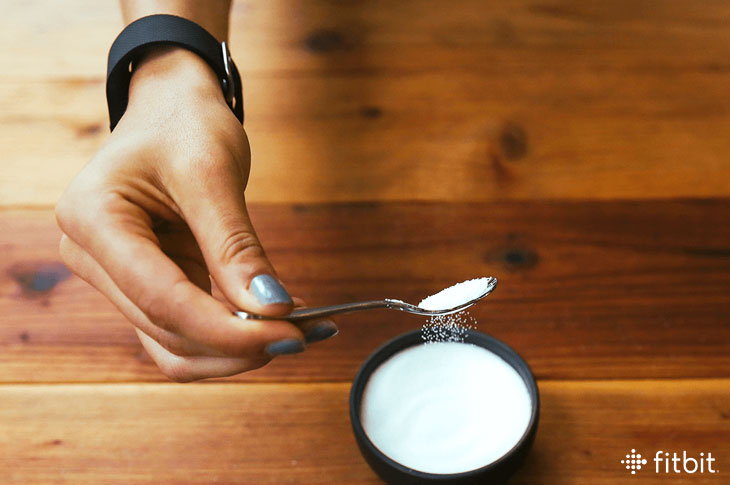
Sodium is an essential nutrient—your body uses it to control blood pressure and blood volume, and muscles and nerves need it to work properly—and your body craves salt for survival. (Scientists think our taste for salt may have something to do with the evolution of animals from sea to land.) But in a modern world filled with too many irresistibly salty processed foods, you’re almost guaranteed to be getting too much. And some experts even believe that years of eating too much salt has created an addiction similar to caffeine and nicotine.
So whether you consider yourself healthy and don’t worry about it, or you’ve been getting an earful from your doctor, here’s why everyone needs to think about salt.
What’s the Difference between Salt and Sodium?
Advice on salt and sodium can be confusing. The dietary guidelines talk specifically about sodium, yet nutritionists tell you to cut back on salt. What’s the difference? Leap back in time to chemistry class: you may remember salt is a chemical element called sodium chloride. So it’s not entirely sodium, but only 40 percent sodium, and the remaining 60 percent is chloride. This simple calculation breaks down the difference:
1 teaspoon salt = 6 grams salt = 2,300 milligrams sodium
What’s handy is that 1 teaspoon of salt also happens to be the recommended daily limit for most people.
Aim for Less than 1 Teaspoon of Salt a Day
For more than three decades the Dietary Guidelines for Americans have recommended reducing sodium. The exact level depends on who you ask. The current guidelines suggest a daily limit of 2,300 milligrams, the World Health Organization recommends 2,000 milligrams, and the American Heart Association puts forward 1,500 milligrams. Some people are more sensitive to the effects of sodium than others—if you’re 51 years or older, African-American, or have high blood pressure, diabetes, or chronic kidney disease, aim for the lower target. No matter your age or background, getting individualized advice from your medical doctor or a registered dietitian is vital.
A recent Canadian study stirred up controversy, suggesting that low-salt diets may be harmful and high-sodium intakes are only bad if you have a high blood pressure. The study has been criticized by the American Heart Association as inaccurate and misleading. Mark Creager, MD, president of the American Heart Association, says, “The link is proven between excess sodium and high blood pressure.” So the general recommendation remains, aim for less than 1 teaspoon of salt per day.
What Happens When You Eat Too Much Salt?
The short answer: High blood pressure—it’s your body’s way of dealing with too much salt. The body compensates by pulling water into your blood to dilute the extra sodium. Extra blood volume means pressure and stress on your delicate blood vessels and kidneys—imagine turning up the tap on a garden hose. If there is a weak spot in the hose, it may spring a leak. A “leak” in your blood vessels, in your heart or brain, is effectively a heart attack or stroke—the two leading causes of death globally.
Evidence shows diets high in salt are one of the leading causes of high blood pressure. Consider that blood pressure increases with age—even if you don’t have a high blood pressure reading now, you have a 90 percent chance of developing it in your lifetime (yes, you read that correctly!). A high salt diet can also be linked to an increased for certain health issues, as well as obesity. And most Americans eat too much—about 3,440 milligrams per day, with men typically consuming way more than women (4,240 milligrams versus 2,980 milligrams).
Even if you’re young, healthy, and have normal blood pressure (for now), throwing back salty pizzas and burgers could have potentially negative consequences. Lowering your salt intake is a relatively easy diet change, and it could make a big difference to your long-term health.
The Sum Is Greater than the Individual Parts
If you want to get a read on your sodium intake, food logging is a great place to start. Enter what you eat for a week or two, and then check out the nutrient breakdown in your Fitbit dashboard online (log in and click on the “dashboard” tab, top left). You’ll get a sense for your stats, and might even notice certain foods, like cereals and sliced bread, chips and pretzels, sauces, and even grocery store muffins, can drive up your sodium intake pretty quickly.
Still, while it’s good to understand the impact of sodium on your health, you never want to get too hyper-focused on one specific nutrient. It’s more important to consider your habits and diet overall. If lowering your salt intake means you’re eating fewer processed foods, great. But remember to increase foods that can balance the negative effects of sodium too, like vegetables, fruit, low-fat and nonfat dairy, legumes, unsalted nuts, and seeds.
This information is for educational purposes only and is not intended as a substitute for medical diagnosis or treatment. You should not use this information to diagnose or treat a health problem or condition. Always check with your doctor before changing your diet, altering your sleep habits, taking supplements, or starting a new fitness routine.

If you have questions about a Fitbit tracker, product availability, or the status of your order, contact our Support Team or search the Fitbit Community for answers.
Please note: Comments are moderated and may not appear immediately after submission.